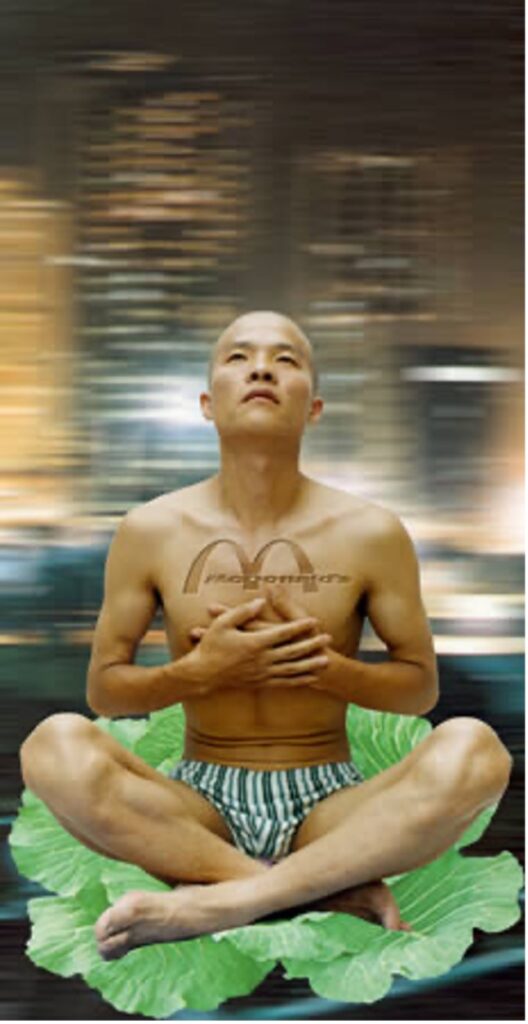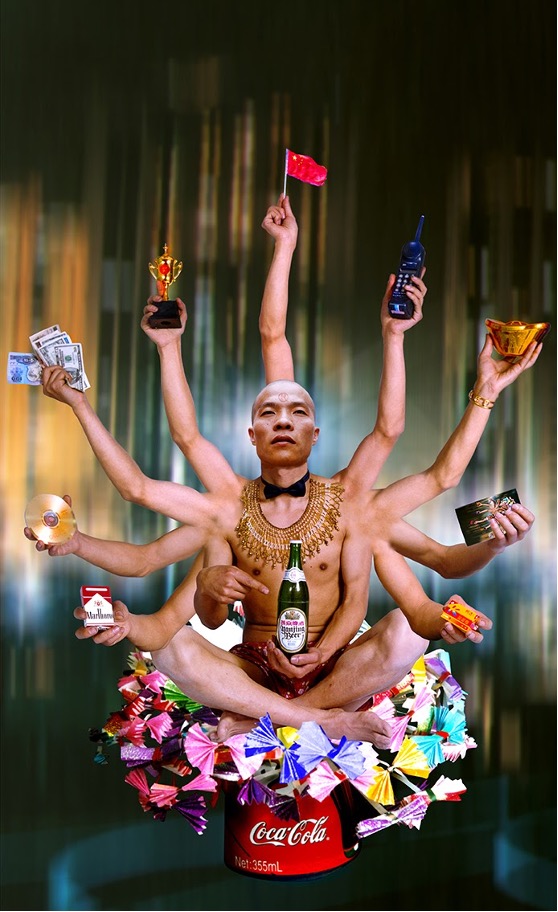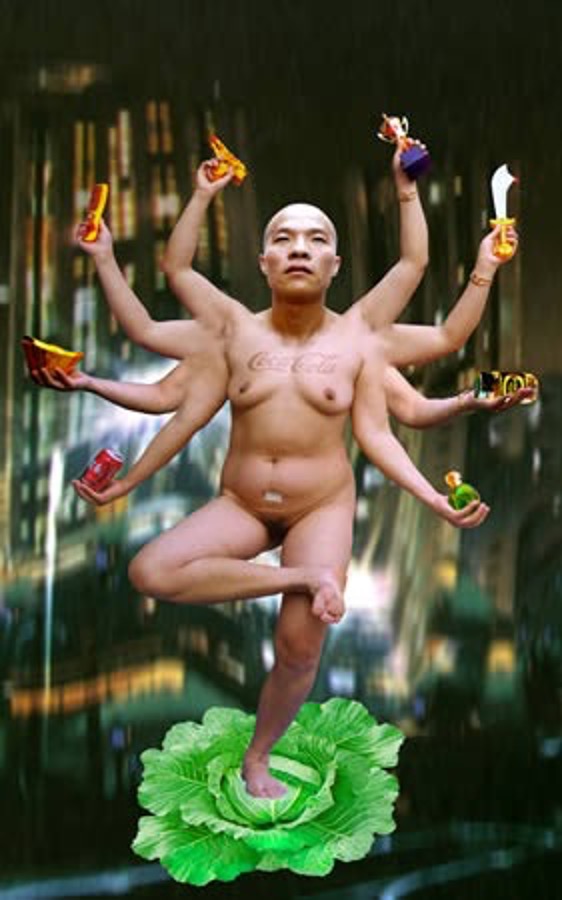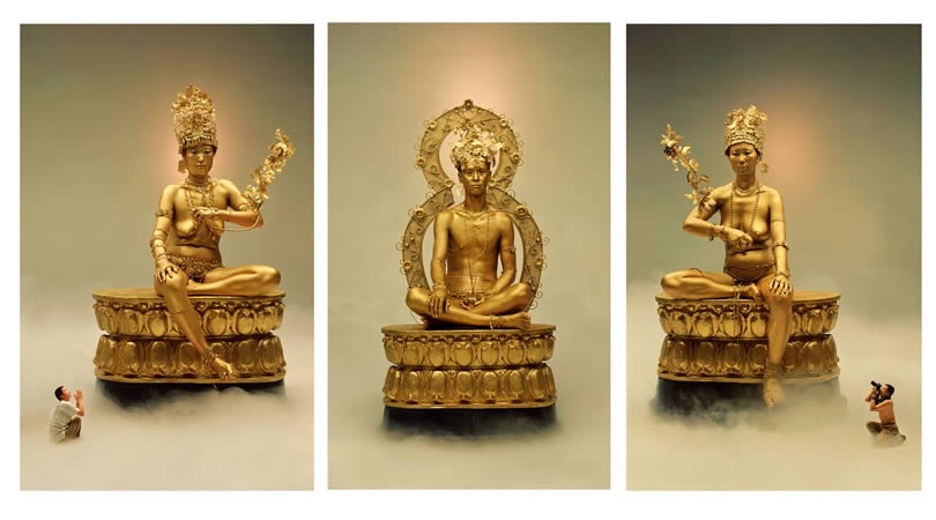Isabella Sorrenti
Overview
This exhibition explores the way in which Chinese artist Wang Qingsong (b.1966) portrays Buddhist ideology and imagery through staged and edited photographs. Wang is known as a theatrical and over-the-top artist who takes risks. He models in many of his photographs, including some in this exhibition as well as using models. Wang grew up in Central China during the Cultural Revolution (1966-1976), the censorship of scholarship and the arts impacted many modern Chinese artists, including Wang. Throughout his work, Wang comments on censorship of media as well as the dissemination of information and truth. At times, Wang takes a more humorous and satirical approach to his art combining modern symbols of consumerism with Buddhist imagery that is inherently sacred. He refers most to seated and standing Buddhist figures. Due to some of the content of some of his photographs, Wang has been criticized in China and was once even detained due to the lude nature of his work. A
The images chosen for this exhibition use traditional Buddhist iconography but are flipped on their head in jarring ways which highlight the disparity between the Buddhist doctrine and modern societies’ relationship with consumerism. In some of the photog
How does Buddhism fit into a fast-paced modern world of mass media? Where does the truth come from and who decides what parts of history are discussed and what is pushed to the side. Wang was particularly influenced by the censorship of art and culture during the Cultural Revolution and saw the impact of the government on disseminating information and deciding what was canonically “true.” Wang’s art pushes the viewer to question their idea of reality and where their information and ideas come from. This exhibition aims to look at the way in which Buddhism appears in modern-day society and where Buddhist imagery appears.
I sourced all the images for this exhibition from the artist’s website. Although they were easy to find, the images are not all of the highest quality, possibly due to fear of censorship. Wang does not have a large online presence but does have an extensive website with an archive of his works as well as a collection of articles on his work as well as a fairly active Facebook page. For this project, it was difficult to only have access to online photos and not be able to see the full scale of his work in person. It was also hard to find first-hand sources and interviews with Wang, again possibly because of censorship and also because he operates now mainly in China, so many of the sources were in Chinese. From what I have seen, it seems as though his work is often simply displayed, a large print hung in the middle of a white wall, and many times he is included in exhibitions with other contemporary Chinese artists.

Title: Thinker
Creator: Wang Qingsong
Date: 1998
Culture: Chinese
Medium: Archival Pigment Print
Dimensions: 180 x 90 cm
Repository: In possession of the artist
Description: This photograph depicts Wang sitting on cabbage in a meditative position with the McDonald’s logo stamped on his chest. His legs are crossed, and hands are placed over his heart while gazing upwards; as if the Buddha sitting upon a lotus flower. The background depicts a blurry city alluding to the rapid modernization of China contrasting with the peacefulness of Wang. The modern consumeristic imagery projected onto the Buddha connects the modern image of China created by the Chinese Communist Party through traditional Buddhist symbols. Wang conrasts such stark imagry to highlight the influence of commercialism on the ancient practice of Buddhism rooted in tradition and working towards Nirvana through the abandoment of materialistic goods.

Creator: Wang Qingsong
Date: 1999
Culture: Chinese
Medium: Archival Pigment Print
Dimensions: 180 x 110 cm
Repository: In possession of the artist

Creator: Wang Qingsong
Date: 1999
Culture: Chinese
Medium: Archival Pigment Print
Dimensions: 180 x 110 cm
Repository: In possession of the artist
Description: In “Buddha Series No.1,” Wang himself sits with his legs crossed in the lotus position with 9 arms coming out from behind him. Each hand holds a different object ranging from a CD and money to a pack of Marlboro cigarettes and a trophy. This figure sits serenely atop a pile of folded paper in a Coca-Cola bucket. In Requesting “Buddha Series No.2,” Wang’s face is photoshopped over a woman’s body who has the Coca-Cola logo on her chest. This figure stands with one leg up and eight arms extending from behind. Again, the hands hold a variety of objects. He stands atop an open cabbage leaf, still and serene against a blurry city background. Similarly to the “Thinker,” Wang contrasts traditional Buddhist poses with modern consumerist items to show the way in which Buddhism today is informed by consumerism and rapid modernization, which inherently goes against the principles of Buddhism.

Title: Incarnation
Creator: Wang Qingsong
Date: 2002
Culture: Chinese
Medium: Archival Pigment Print
Dimensions: 190 x (120, 115, 120) cm
Repository: In possession of the artist
Description: In this triptych, there are three statues all gilded and seated on a carved lotus flower. The figures on top are models painted gold with somber expressions. The first statue is a nude woman with her right hand on her knee with her left arm bent across her chest horizontally. The second model is a male seated in the lotus position surrounded by a gilded halo; arms placed gently in his lap. The third statue mirrors the first with the arms and legs in the opposite position. In the first photo, a man kneels praying to the larger-than-life-size statue; whereas the woman with a camera kneels and photographs the statue. All three of these statues are very similar to traditinal seated Buddha iconography although none of them preform traditional hand mudras. The size of the statues compared to the people viewing them suggest their power. The figure on the right photographing the statues comments on tourism to Buddhist palces and the reality that many of the people visiting are not aware of the power and importance that the figures actually hold.

Title: Offering
Creator: Wang Qingsong
Date: 2003
Culture: Chinese
Medium: Archival Pigment Print
Dimensions: 120 x 230 cm
Repository: In possession of the artist
Description: This picture was one of the first cinematic designs of Wang. Naked actors wading through deep blue water offer forward various offerings including flowers and statues. They reach out longingly toward the golden depiction of the Goddess of Mercy, Guanyin. She sits upon a lotus flower, symbolizing her enlightenment and wisdom while also being surrounded by a golden halo to signify her divinity. The position of the people in the water is reminiscent of the Island of Pluto, the Goddess’s home, which today is a tourist attraction and an important pilgrimage site in East Asia. Wang stands in the background actively scrutinizing the worship of a Goddess as the land is flooded. The artist combines traditional elements of Buddhism with a surreal scene to convey ideas about the modernization of Buddhism and the idea of “fake” Buddhism. The “fakeness” of Buddhism is conveyed through the clearly painted woman acting as the true statue of Guanyin, as well as the random offerings brought by the devotees. Buddhist worship and practices are ancient ideas and here they are trivialized by naked devotees in front of a fake statue.

Title: Temple
Creator: Wang Qingsong
Date: 2011
Culture: Chinese
Medium: Archival Pigment Print
Dimensions: 180 x 300 cm
Repository: In possession of the artist
Description: A mammoth gilded Future Buddha sits in the middle of a dark room, smiling and chubby. This representation of the Future Buddha is a typical Chinese representation. The walls around him is covered in hundreds of Buddha heads and naked worshipers kneel. The people are covered in dirt and bow their heads, their filth contrasted with the bright sheen of the Buddha. The nakedness and dirtiness of the devotees is jarring to the viewer as well as an uncomortable image due to the religious and sacred nature of the Buddha and consequently a space. Here, Wang once again explores the idea of “fake Buddhism” as the viewer is promted to question the legitimacy of these people’s devotion and true motivation to pray as these unidentifiable people kneel to the Buddha.
Bibliography
Images
“Follow Me (Lesson Eight) by Wang Qingsong.” Sedition, https://www.seditionart.com/wang-qingsong/follow-me.
Qingsong, Wang. “Incarnation.” Wang Qingsong Studio, Wang Qingsong, 2002, http://www.wangqingsong.com/index.php?option=com_content&view=article&id=71&Itemid=14. Accessed 2021.
Qingsong, Wang. “Offerings.” Wang Qingsong Studio, Wang Qingsong , 2003, http://www.wangqingsong.com/index.php?option=com_content&view=article&id=83&Itemid=15. Accessed 2021.
Qingsong, Wang. “Preincarnation.” Wang Qingsong Studio, Wang Qingsong , 2002, http://www.wangqingsong.com/index.php?option=com_content&view=article&id=70&Itemid=14. Accessed 2021.
Qingsong, Wang. “Temple.” Wang Qingsong Studio, Wang Qingsong , 2011, http://www.wangqingsong.com/index.php?option=com_content&view=article&id=275&It
Qingsong, Wang. “Thinker.” Wang Qingsong Studio, Wang Qingsong, 1998, http://www.wangqingsong.com/index.php?option=com_content&view=article&id=50&Itemid=11.
Qingsong, Wang. “Requesting Buddha Series No. 1 .” Wang Qingsong Studio, Wang Qingsong, 1999, http://www.wangqingsong.com/index.php?option=com_content&view=article&id=51&Itemid=11. Accessed 2021.
Qingsong, Wang. “Requesting Buddha Series No. 2 .” Wang Qingsong Studio, Wang Qingsong, 1999, http://www.wangqingsong.com/index.php?option=com_content&view=article&id=52&Itemid=11. Accessed 2021.
Texts
Cabos-Brullé, Marine. “Wang Qingsong.” Photography of China, Photography of China, 5 Mar. 2020, https://photographyofchina.com/blog/wang-qingsong.
Escalera, Karen. “Frost Art Museum: Wang Qingsong.” Miami Curated, 7 Nov. 2014, https://www.miamicurated.com/culture/asian-art-miami/.
Knight, Christopher. “Art Review; Groping Toward the Significant; In an Uneven Survey of New East Asian Art, What Stands Out Is the Full-Throttle Transformation of China: Home Edition.” The Los Angeles Times, Los Angeles Times Communications LLC, 2004.
Floriani, Giulia Pra. “‘The History of Monuments’ of Wang Qingsong.” Wang Quinsong Studio, June 2015, http://www.wangqingsong.com/index.php?option=com_content&view=article&id=300&Itemid=43&lang=en.
“Follow Me (Lesson Eight) by Wang Qingsong.” Sedition, https://www.seditionart.com/wang-qingsong/follow-me.
Glover, Michael. “Photography: How now, my old China? Between Past and Future: New Photogrpahy and Video From China V&A London.” Independent, London, England, 30 Nov. 2005, p. 52. Gale Health and Wellness, link.gale.com/apps/doc/A139237967/HWRC?u=connc_main&sid=bookmark-HWRC&xid=0ef4b35f. Accessed 31 Oct. 2021.
Karetzky, Patricia Eichenbaum. “Wang Qingsong’s Use of Buddhist Imagery.” Wang Qinsong Studio, Wang Qinsong, http://www.wangqingsong.com/index.php?option=com_content&view=article&id=280&Itemid=41&lang=en.
Kuan, Christine.“Wang Qingsong.” Oxford Art Online, https://www.oxfordartonline.com/page/wang-qingsong. Accessed 2021.
Ortells-Nicolau, Xavier. “Raised into Ruins: Transforming Debris in Contemporary Photography from China,”Frontiers of Literary Studies in China 11, 2 (2017): 263-297, doi: https://doi.org/10.3868/s010-006-017-0012-8
Peschel, Sabine. “Germany Opens Its Largest-Ever Show of Modern Chinese Art.” DW, 13 May 2015, https://www.dw.com/en/germany-opens-its-largest-ever-show-of-modern-chinese-art/a-18448377.
Pollack, Barbra. “Wang Qingsong: Brush with Censorship.” Artnet.com. Accessed December 6, 2021. http://www.artnet.com/magazineus/features/pollack/wang-qingsong1-25-11.asp.
Riches, Harriet, P.H.D. “Wang Qingsong.” Afterimage 43, no. 4 (Jan 2016): 39. https://login.peach.conncoll.edu/login?url=https://www.proquest.com/scholarly-journals/wang-qingsong/docview/1769408175/se-2?accountid=10255.
Rosenberg, Karen. “As China Evolves, so does an Artist: [Review].” New York Times, Jan 28, 2011. ProQuest, https://login.peach.conncoll.edu/login?url=https://www.proquest.com/newspapers/as-china-evolves-so-does-artist/docview/847580379/se-2?accountid=10255.
Siyue, Ding. “Wang Qingsong’s Exhibition in Beijing Shares Hope with Viewers.” CGTN, CGTN, 14 July 2020, https://news.cgtn.com/news/2020-07-14/Wang-Qingsong-s-exhibition-in-Beijing-shares-hope-with-viewers-S7mxTYQOrK/index.html.
“Smart Museum of Art.” Between Past and Future: New Photography and Video from China | Smart Museum of Art, University of Chicago , 2004, https://smartmuseum.uchicago.edu/exhibitions/between-past-and-future-new-photography-and-video-from-china/.
Tatehata, Akira. “Asian Contemporary Art and Internationalism.” Grove Art Online, 22. Oxford University Press. Date of access 1 Nov. 2021, <https://www.oxfordartonline.com/groveart/view/10.1093/gao/9781884446054.001.0001/oao-9781884446054-e-7000097922>
Tang, Clara. “Works in Progress: Photography from China.” Art and Asia Pacific, no. 95, 2015, p. 144.
“Wang Qingsong: Adinfinitum.” Asia Art Archive in America, The Patricia & Phillip Frost Art Museum, 4 Dec. 2014, https://www.aaa-a.org/events/wang-qingsong-adinfinitum/.
“Wang Qingsong: Debacle.” Huxley- Parlour, Huxley- Parlour, 10 Aug. 2015, https://huxleyparlour.com/exhibitions/wang-qingsong/.